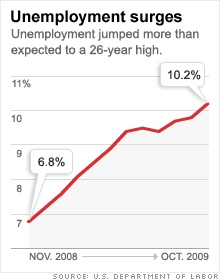Unemployment hits 10.2%
The unemployment rate spiked to its highest level since 1983, much worse than expected as employers continue to trim jobs despite other signs of growth.

NEW YORK (CNNMoney.com) -- The nation's unemployment rate rose above 10% for the first time since 1983 in October, a much worse jump than expected as employers continued to trim jobs from payrolls.
The reading, reported by the government Friday, is a sign of the continued weakness in the labor market even though the economy grew in the third quarter following the longest and deepest downturn since the Great Depression.
The government reported that the unemployment rate spiked to 10.2%, up from 9.8% in September. It is the highest that this rate has been since April 1983. Economists had forecast an increase to 9.9%.
There was also a net loss of 190,000 jobs in October, according to the Labor Department, an improvement from a revised estimate of 219,000 job losses in September. However, economists surveyed by Briefing.com had forecast a loss of only 175,000 jobs in October. This was the 22nd straight month of job losses.
"The only good news is the number of layoffs are dropping off, but those who are laid off still aren't finding jobs," said David Wyss, chief economist with Standard & Poor's.
The jump in the unemployment rate was driven up by a large drop in the number of people who describe themselves as self-employed, as well as the number of teenagers who have jobs. The unemployment rate for teenagers in the labor force soared to 27.6%, up 1.8 percentage points and hitting a third straight record high.
Both teen workers and the self-employed are not captured very well in the government's separate survey of employers that is used to calculate the number of people on U.S. payrolls. That explains much of the disconnect between fewer job losses overall and the much worse unemployment rate.
The rise in unemployment was not spread evenly across the population. For those with college degrees, the unemployment rate fell to 4.7% from 4.9% in September, as the unemployment rate for those in management, professional, and related occupations slipped to 4.7% from 5.2%.
But the unemployment rate for production jobs, such as factory workers, jumped to 14.5% from 14.1%. The jobless rate for workers in construction, maintenance or natural resources industries such as mining rose to 15.5% from 14.3%.
"There's a real mismatch between the unemployed people out there compared to what job openings are available," said John Silvia, chief economist with Wells Fargo Securities. He said construction workers who lost a job when the housing bubble burst don't have the skills to compete for jobs in sectors that are hiring, such as health care and technology.
Government efforts to end job losses have had limited effects, although the Obama administration estimated last month that 640,000 jobs were created or saved by the federal stimulus package passed earlier this year. But that's modest compared to the 7.3 million jobs that have been lost since the start of 2008.
Christina Romer, chair of the President's Council of Economic Advisors, said the steady decline in monthly job losses since earlier this year is a hopeful sign for the economy.
But she acknowledged there's still significant pain for those looking for work. "Having the unemployment rate reach double-digits is a stark reminder of how much work remains to be done before American families see the job gains and reduced unemployment that they need and deserve," she said.
Friday's report comes one day after Congress voted overwhelmingly to extend unemployment benefits by up to 20 weeks. There are now a record 5.6 million people who have been unemployed for six months or longer, as the average time an unemployed person has been out of a job hit 26.9 weeks.
Prior to this report, most economists had believed that the unemployment rate would keep rising and that job losses would continue into next year. But the jump in unemployment in October took it to levels worse than what many previously had expected to be the peak.
According to a survey of top forecasters by the National Association of Business Economics last month, the consensus estimate among economists was that unemployment would hit a high of 10% in the final three months of this year and the first quarter of 2010.
The five economists with the most bearish forecasts had expected unemployment to rise to 10.2% in the fourth quarter of this year before hitting 10.5% in the first half of next year.
Wyss is one of those economists who had projected an unemployment rate of 10.5% in the middle of next year. He said Friday's report may force him to raise his worst case estimate.
"Some things aren't playing out the way I expected them to," he said. "There's just no good news in this report."
But others said they see some early signs of life for the labor market. Sung Won Sohn, economics professor at California State University Channel Islands, noted that the biggest increase in temporary employees in two years took place in October.
Employers typically bring in workers on a temporary basis before deciding to make more permanent hires. As such, he expects gains in payrolls by next spring.
"Despite the gloomy job picture, there are some encouraging signs," he said.
Congress approves extended jobless benefits



